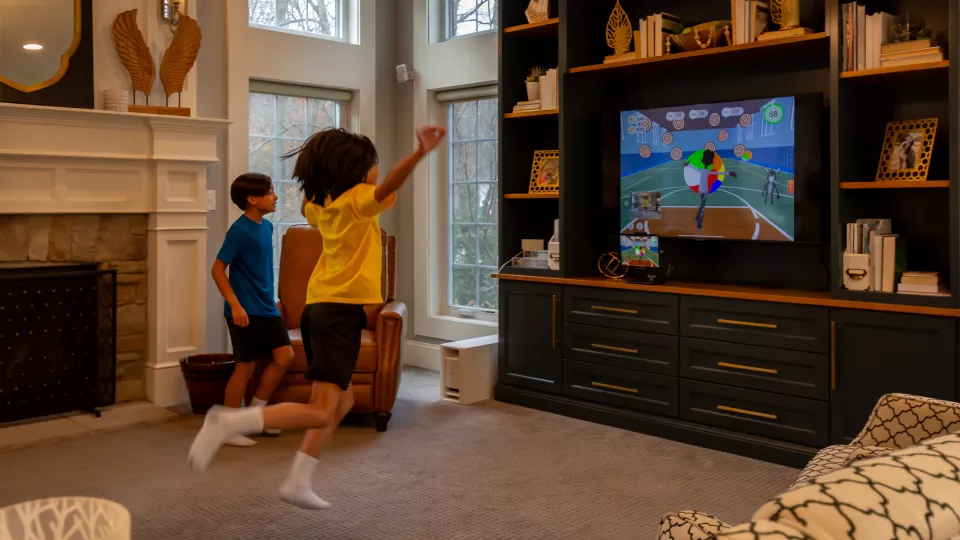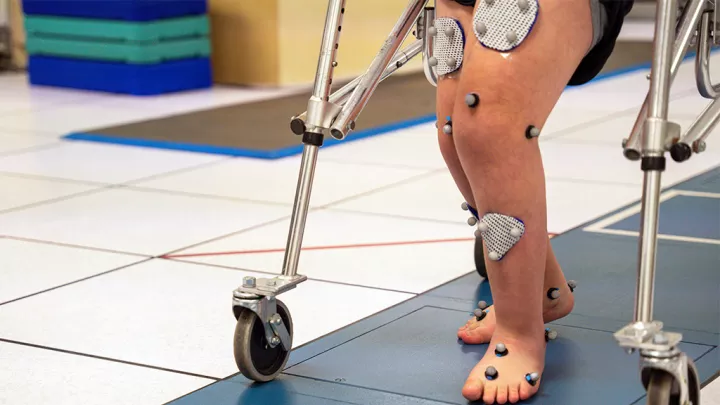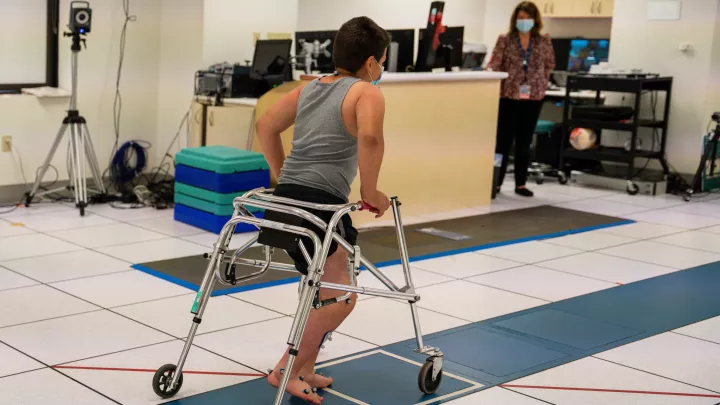
A child kicks a virtual ball in one of the augmented reality games as a friend looks on. Photo used with permission from Augment Therapy.
Can Augmented Reality Improve Exercise for Children With Cerebral Palsy?
Exercise plays a key role in helping children with cerebral palsy to improve or maintain their mobility, including the ability to walk. But research has shown that many of these kids don’t get the physical activity they need.
Now, a new pilot study at Children’s Hospital Los Angeles is testing whether an augmented reality exergaming program can help these children better adhere to home therapy.
Principal Investigator Melissa Bent, MD, a pediatric orthopedist in the Jackie and Gene Autry Orthopedic Center at Children’s Hospital Los Angeles, presented results from the trial’s first phase at the 2024 Association for Clinical and Translational Science meeting, held April 3-5 in Las Vegas.
“Issues with access and usability often prevent children with cerebral palsy from participating in exercise,” Dr. Bent says. “The hope is that augmented reality will help improve that access and be more engaging for kids.”
Flying in a virtual world

The study is a partnership with Augment Therapy, which develops gamified exercise programs for pediatric rehabilitation. In 2021, the startup was one of 13 companies selected for the inaugural KidsX Pediatric Digital Health Accelerator, which is anchored by a consortium of children’s hospitals, including CHLA.
The randomized trial, which launched this spring, will enroll 30 children with cerebral palsy between the ages of 5 and 10. All children must be able to walk in most settings and be classified at Levels I or II on the Gross Motor Function Classification System (GMFCS) scale.
Participants will be randomized into two groups for a three-month at-home exercise program. One group will exercise with the augmented reality games, and the other group will be assigned to a standard home exercise program.
Unlike with virtual reality, the games do not use any headsets or wearables. Instead, children see a digital overlay of themselves in a virtual 3D world on the screen. An iPad tracks children’s movements as they play the game, controlling their avatar character on the screen with their body.
For example, in one game, children navigate an obstacle course—which requires them to bend down, squat, jump and more. In another game, children must make certain arm movements and maintain their balance as they make their avatar fly on screen.
“We don’t give them specific exercises,” Dr. Bent says. “We just put them in the game.”
Participants in both groups will log their time and answer a survey. The app also tracks the time the child spends with the games.
Early findings

At the conference, Dr. Bent presented findings from the study’s preliminary phase, which enrolled six children under the same criteria and took place last summer.
The goal of that phase was to gather user-experience data in the clinic to inform the randomized trial. Although the sample size was small, the team found that the games were well-accepted, with 83% of participants reporting that the avatar matched their child’s movements and the game was easy for their child to play.
All participants also expressed interest in enrolling in the randomized at-home trial.
If results from the trial are positive, Dr. Bent hopes to eventually launch a larger clinical trial and test the app with children who have more severe motor impairments.
“Cerebral palsy is the most common motor disability in childhood, so finding ways to move the needle in terms of engagement with rehabilitation is important,” she says. “We want to see if gamification can help us do that.”
Additional study authors were Abigail Padilla BS; Susan A. Rethlefsen, PT, DPT; Alison Hanson, PT, DPT; Eva Ciccodicola, PT, DPT; and Tishya AL Wren, PhD.


